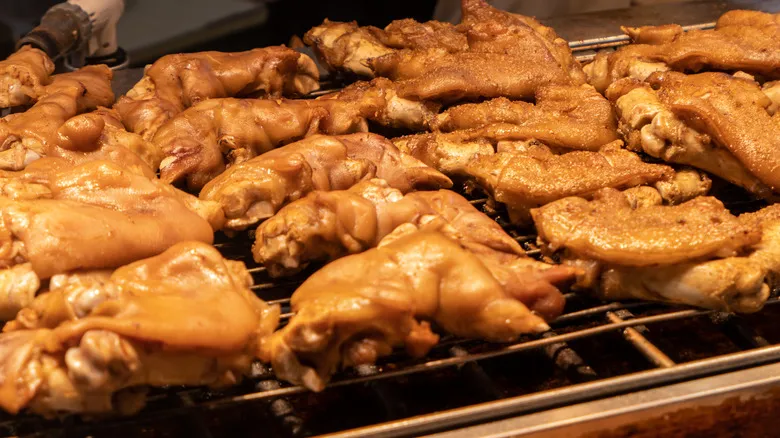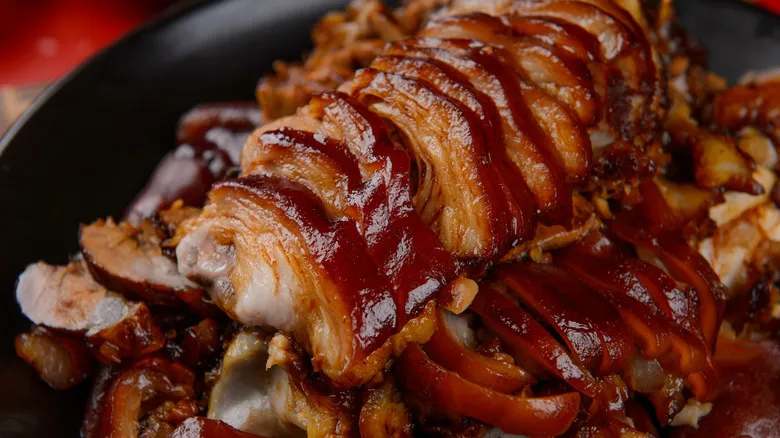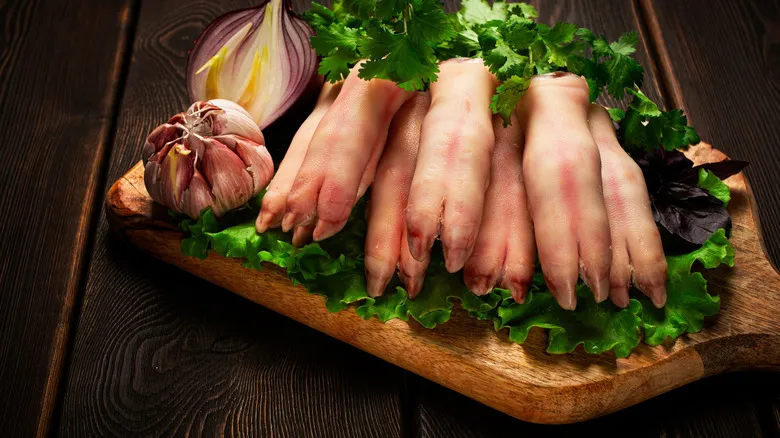How to cook pig's feet

Preparing pig's feet presents three main challenges. First, each foot should be halved lengthwise to allow for easier access to the meat. Unless you possess the skills of a master like the renowned chef Pierre Kaufmann, it's advisable to have the butcher cut them in half for you. Even seasoned chefs can take around five minutes to completely debone a single foot.
Next, thorough cleaning is essential, as they are, after all, feet. Some individuals prefer to soak them overnight in cold water in the refrigerator, followed by a good rinse. Others opt for rinsing them in vinegar or a vinegar-water solution, as vinegar serves as a moderately effective antibacterial and antifungal agent. Additionally, vinegar imparts a subtle mustardy flavor that complements the sweet and smoky richness of well-cooked pig's feet, evoking a sense of tradition or nostalgia for many.
Lastly, the cooking process typically requires a significant amount of time. Braising, boiling, or baking can take anywhere from two to four hours to achieve the desired tenderness. Some recipes even call for multiple cooking methods, such as braising for three hours before finishing on the grill. The extended cooking time helps break down collagen and gelatin in the meat, making it easier to separate from the bone. To expedite the cooking process, you can use an Instant Pot or another pressure cooker; with a couple of cups of water, the feet should become tender and delicious in about an hour.
Pro tips for making the best pig's feet

There are several handy tips for preparing pig's feet. If the trotters are sourced directly from a farm or a specialty shop, you might want to remove any hairs from the skin. Exercise caution if you choose to process the hooves yourself, as the numerous small bones can make cutting challenging. It’s beneficial to watch a few instructional videos to master the deboning or splitting techniques.
When boiling, be ready to frequently skim off the gelatinous foam that rises to the surface. If you’re braising the trotters, remember to check on them regularly and add moisture as necessary. If the dish dries out, the combination of high heat, rendered collagen, and sugars from sauces can turn into a glue-like substance, potentially damaging your cooking vessel.
If you’re skilled at boning and skinning pig's feet, you can fill them with a variety of ingredients, from vegetables to lobster or sausage, for a rich, smoky-savory delight. Alternatively, you can remove the skins entirely after cooking and transform them into cracklings or chicharrones. If you prefer your final dish not to resemble feet, ensure everything is cooked until it falls off the bone, then separate the components before serving. Another option is to incorporate pieces into a hot pot dish, or to remove all bones and tendons, finely chop the meat and skin, form small patties, and then bread and fry them. Trotters are often enjoyed with a sauce, as their robust pork flavor pairs well with spicy hot sauces, seasonings, or sticky-sweet barbecue sauce.
Where to find pig's feet

Pig's feet are not particularly uncommon or exotic. They can be found on menus nationwide, ranging from upscale Parisian eateries to casual Southern soul food joints. They play a significant role in many diets around the world, except for the billions who avoid pork entirely. Each pig has four feet, and the average meat consumer will likely eat nearly 30 pigs over their lifetime. So, why aren't they more prevalent? It all comes down to knowing where to find them.
Trotters can sometimes be found in the meat section of grocery stores. You can inquire at the butcher counter, and they might be able to assist you. Alternatively, visiting a dedicated butcher shop or an Asian specialty store will almost certainly yield results. For instance, at T&T Supermarkets in Canada and Washington state, you can purchase three pounds for around $10.
Pickled pig's feet were once a common snack in industrial dive bars and roadside taverns across the country, but they've become somewhat scarce in modern bars. Nevertheless, you can still find jars of Hormel pickled pig's feet in many grocery stores throughout the American South, or you can opt for a more upscale option and order a 16-ounce jar of Hannah's ready-to-eat pickled pig's feet for approximately $17.
Recommended

10 Easy Tips To Reduce Food Waste

The Ultimate Guide To Buying Olive Oil

13 Foods You Should Never Put Down Your Kitchen Sink

How To Tone Down The Heat Of Your Homemade Hot Sauce
Next up

